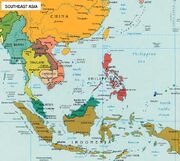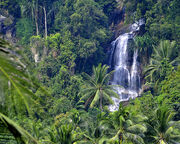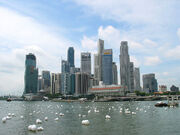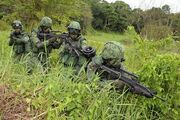| Southeast Coalition | |||
|---|---|---|---|
| |||
| Motto Dum Spiro Spero |
|||
| National Anthem Through The Valley | |||
| Capital | Singapore | ||
| Largest City | Singapore | ||
| Official languages | English, Chinese, Malay, Tamil | ||
| Demonym | Southeast Coalitioner | ||
| Government | Democracy | ||
| - Prime Minister of SEC | Bryan Minghan | ||
| - Commander-in-Chief of SECM | Jacob Imran | ||
| - Executive | Bryan Minghan | ||
| - Legislature | SEC Congress | ||
| - Judicial | Supreme Court of the SEC | ||
| Formation - SEC Formation |
11 February 2011[1] |
||
| Major Religions | Christianity | ||
| National Animal | Crane | ||
| Total Area | 20.480 sq. miles | ||
| Total Population - Ethnic Groups |
681 Chinese, Malay, Indian, Eurasian |
||
| Alliance Affiliation | The Conservative Underground | ||
| Currency | Dollar | ||
| Literacy Rate | 20.00% | ||
| Driving Lane | Left | ||
| Time Zone | (GMT +8) | ||
Southeast Coalition (also referred as SEC) is a sovereign coalition of former ASEAN nations (namely Singapore, Malaysia and Indonesia). After World War Three, the nations of ASEAN held an emergency meeting in Singapore city to discuss the future of Southeast Asia. The meeting led to the formation of the Southeast Coalition with Singapore as the current leader. Member nations of ASEAN would join the coalition at a later date as the coalition grows in economic, political and military power. This would ensure that peace and freedom lives on in the region.
History[]
On February 15, 2011, the SEC adopted and celebrated Singapore's Total Defence Day which signifies the start of the Japanese Occupation of Southeast Asia and the defeat of the colonial British government during World War Two on February 15, 1942. Total Defence Day will be celebrated annually on February 15 to commemorate the anniversary of the surrender of the British to the Japanese on February 15, 1942, precursoring 3 years and 8 months of Japanese Occupation.
At 1205, the Important Message Signal was sounded through the nation. Simultaneously at 1205 hours, 10 local radio stations sounded the important message signal and explained to the listeners on the appropriate measures to be taken for the three different types of PWS signals. After the sounding, schools read out a Civil Defence message in which students were reminded of the significance of the PWS signals and appropriate measures to be taken.
Geography, climate and environment[]
Geologically, the Indonesian archipelago is one of the most active vulcanological regions in the world. Geological uplifts in the region have also produced some impressive mountains, culminating in Puncak Jaya in Papua, Indonesia at 5,030 metres (16,024 ft), on the island of New Guinea, it is the only place where ice glacier can be found in Southeast Asia. While the second tallest peak is Mount Kinabalu in Sabah, Malaysia on the island of Borneo with a height of 4,095 meters (13,435 ft). The highest mountain in the Southeast Asia is Hkakabo Razi at 5,967 meters and can be found in northern Burma sharing the same range of its parent peak, Mount Everest. The largest archipelago in the world by size is Indonesia (according to the CIA World Factbook)
Boundaries[]

Map of Southeast Asia
The Australian continent defines a region adjacent to Southeast Asia, which is also politically separated from the countries of Southeast Asia. But a cultural touch point lies between Papua New Guinea and the Indonesian region of Papua and West Papua, which shares the island of New Guinea with Papua New Guinea.
Climate[]
The climate in Southeast Asia is mainly tropical–hot and humid all year round with plentiful rainfall. Southeast Asia has a wet and dry season caused by seasonal shift in winds or monsoon. The tropical rain belt causes additional rainfall during the monsoon season. The rain forest is the second largest on earth (with the Amazon being the largest). An exception to this type of climate and vegetation is the mountain areas in the northern region, where high altitudes lead to milder temperatures and drier landscape. Other parts fall out of this climate because they are desert like.
Environment[]

Lush primary tropical rainforest is a trademark of most of the area

The cityscape of Singapore, the SEC's capital city
All of Southeast Asia falls within the warm, humid tropics, and its climate generally can be characterized as monsoonal. The animals of Southeast Asia are diverse; on the islands of Borneo and Sumatra, the Orangutan (man of the forest), the Asian Elephant, the Malayan tapir, the Sumatran Rhinoceros and the Bornean Clouded Leopard can be also found. Six subspecies of the Binturong or bearcat exist in the region, though the one endemic to the island of Palawan is now classed as vulnerable.
The shallow waters of the Southeast Asian coral reefs have the highest levels of biodiversity for the world's marine ecosystems, where coral, fish and molluscs abound. According to Conservation International, marine surveys suggest that the marine life diversity in the Raja Ampat area is the highest recorded on Earth. Diversity is considerably greater than any other area sampled in the Coral Triangle composed of Indonesia, Philippines and Papua New Guinea. The Coral Triangle is the heart of the world's coral reef biodiversity, making Raja Ampat quite possibly the richest coral reef ecosystems in the world. The whale shark, the world's largest species of fish and 6 species of pawikans can also be found in the South China Sea and the Pacific Ocean territories of the Philippines.
The trees and other plants of the region are tropical; in some countries where the mountains are tall enough, temperate-climate vegetation can be found. These rainforest areas are currently being logged-over, especially in Borneo. While Southeast Asia is rich in flora and fauna, Southeast Asia is facing severe deforestation which causes habitat loss for various endangered species such as orangutan and the Sumatran tiger. Haze has been a regular occurrence. The two worst regional hazes were in 1997 and 2006 in which multiple countries were covered with thick haze, mostly caused by "slash and burn" activities in Indonesia. In reaction, several countries in Southeast Asia signed the ASEAN Agreement on Transboundary Haze Pollution in order to combat haze pollution.
Economy[]
The SEC has a market-based economy. The economy depends on a mix of manufacturing and agriculture. The SEC has a goods and services tax which currently stands at 7%, as of 12 February 2011.
Military[]

SECAF Soldiers armed with SAR-21 Assault Rifles

SECAF Bionix 2 Armoured Fighting Vehicle
Southeast Coalition Armed Forces serves the role of the military in the SEC. The Ministry of Defence (MINDEF), currently headed by Minister Jacob Imran, oversees the SEC Army, the SEC Navy, and the SEC Air Force, collectively known as the SEC Armed Forces, along with volunteer private companies in supporting roles. The armed forces serve primarily as a deterrent against potential aggressors and also provide humanitarian assistance to other countries. The Singaporean concept and strategy of "Total Defence" has been adopted in all aspects of security, aimed at strengthening SEC against all kinds of threats.
SEC legislation requires every able-bodied male Singapore citizen and permanent resident to undertake National Service for a minimum of two years upon reaching 18 years of age or completion of his studies (whichever comes first), with exemption on medical or other grounds. After serving for two years, every male is considered operationally ready, and is liable for reservist national service to the age of 40 (50 for commissioned officers). Those medically fit must also take the Individual Physical Proficiency Test (IPPT) yearly as part of their training program. SEC's defence resources have been used in international humanitarian aid missions, including United Nations peacekeeping assignments.
| Current Signatories | |
|---|---|
|
|
|
| Former Signatories | |
|
|
| Observers | |
| Former Observers | |
| Self-Declared Signatories | |
